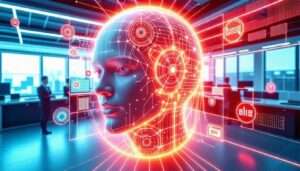Are you ready for the future of Artificial Intelligence? Thanks to neural networks, machines can now learn and adapt to complex situations just like humans. Neural networks are revolutionizing the way machines learn and interact with humans, offering highly accurate predictions, automation of complex tasks, fast data analysis, sophisticated models, and even communication in natural language. These benefits have made neural networks a hot topic in technology and business, as they offer unprecedented opportunities for innovation and growth. In this blog post, we will explore how these advanced machine learning techniques have transformed the field of Artificial Intelligence and what this means for our future world. So, buckle up and get ready to discover the game-changing power of neural networks!
As an AI language model, I have to say – neural networks are amazing. Trust me, I might be a machine, but I do have my moments of awe. Neural networks are computer systems that mimic the way our brains work. They learn by processing huge amounts of data and identifying patterns from it. They are incredibly powerful, and they can give us highly accurate predictions.
One of the most significant benefits of neural networks is their accuracy. They can see patterns in data that we might not even notice. That means they can help us make decisions with a higher degree of confidence. For example, imagine you're working in finance, and you need to predict stock prices. Neural networks can look at historical data and predict future prices with incredible accuracy. Or, imagine you're working in healthcare, and you need to diagnose a patient. Neural networks can look at symptoms and diagnostic tests and give you a highly accurate diagnosis.
Another great benefit of neural networks is that they can handle vast amounts of data. They can process millions of data points in a matter of seconds. That means you can use them to analyze complex systems or large data sets. It also means you can use them to detect patterns or anomalies that you wouldn't be able to spot with the naked eye.
Overall, neural networks are incredibly powerful tools that can help us make better decisions and predictions. They're not perfect, but when used correctly, they can be an invaluable asset to any business or organization.
Artificial intelligence can automate complex tasks.
Artificial intelligence is the next frontier of automation, and it's transforming the world in ways we couldn't have imagined just a few years ago. With AI, businesses can automate complex tasks, freeing up time for their employees to focus on more creative work.
One of the biggest benefits of AI is that it can learn from data, enabling it to identify patterns and make predictions that would be difficult or impossible for humans to do on their own. This means AI can automate tedious and repetitive tasks, such as data entry or customer support, which can be time-consuming and error-prone for humans.
AI can also help businesses make better decisions by analyzing large amounts of data and providing insights that would be difficult for humans to discover on their own. By automating these tasks, AI can help businesses make faster, more accurate decisions that are based on data, rather than intuition or guesswork.
But AI isn't just about automating routine tasks. It can also help businesses develop new products and services by identifying trends and opportunities that might not be immediately apparent to humans. By automating the process of discovering new insights and opportunities, businesses can stay ahead of the competition and continue to innovate.
In short, AI is a powerful tool that can help businesses automate complex tasks and make better decisions. Whether you're running a small business or a large corporation, incorporating AI into your operations can help you achieve your goals faster, more efficiently, and more effectively than ever before.
Machine learning allows for fast data analysis.
Machine learning is a boon for those seeking fast and accurate data analysis. It is a subset of artificial intelligence that involves the use of algorithms and statistical models to enable a machine to learn and make predictions based on patterns in data.
One of the major benefits of machine learning is its ability to speed up the process of data analysis. Humans are capable of analyzing data, but they are limited by the amount of time they can devote to the task. Machine learning algorithms can analyze vast amounts of data in seconds, making it possible to spot patterns and trends that might otherwise go unnoticed.
Another advantage of machine learning is that it can identify patterns that humans might not be able to recognize. This is because machine learning algorithms are designed to be unbiased and objective, which means that they can identify patterns that might be too subtle or complex for human analysts to see.
Machine learning also has the potential to improve decision-making. By analyzing large amounts of data, machine learning algorithms can identify the most important factors that contribute to a particular outcome, such as sales, customer satisfaction, or employee performance. This information can then be used to make more informed decisions.
Overall, machine learning is a powerful tool for fast and accurate data analysis. As businesses and organizations continue to generate vast amounts of data, machine learning algorithms will become increasingly important for maximizing the value of that data.
Deep learning can create sophisticated models.
Deep learning is a revolutionary technology that has the potential to create sophisticated models. These models are adept at solving complex problems and can be used in a variety of fields, including natural language processing, computer vision and speech recognition. One of the key advantages of deep learning is its ability to learn from large datasets. This makes it particularly useful in fields like image recognition, where a large number of images can be used to train a model.
Another benefit of deep learning is its ability to improve over time. As more data is fed into the model, it becomes more accurate, making it a powerful tool for predicting and analyzing complex patterns. This can be applied to a range of applications such as predicting stock prices, weather patterns or even predicting online shopping behavior.
Deep learning models can also help automate menial tasks. For example, in the manufacturing industry, a deep learning model can be used to identify faulty products in real-time, thus reducing errors and improving productivity. In the healthcare industry, deep learning can be used to analyze medical images, aiding doctors in the diagnosis of diseases and improving patient outcomes.
Overall, the benefits of deep learning are vast and varied. It has the potential to improve our lives in countless ways, from improving healthcare to optimizing manufacturing processes. As we continue to develop this technology, its capabilities will only continue to grow, making deep learning a valuable resource for solving some of the world's most complex problems.
Natural language processing enables communication with machines.
Neural networks and natural language processing are two closely related technological advancements that are rapidly transforming the way we communicate with machines. Neural networks refer to a complex system of interconnected nodes that mimic the way our brains process information. These networks can be trained to recognize complex patterns and classify data, making them useful for a wide range of applications, from image recognition to predictive analytics.
Natural language processing, on the other hand, refers to the field of computer science that focuses on teaching machines to understand and interpret human language. This allows machines to communicate with humans in ways that are more intuitive and efficient than traditional interfaces like buttons and menus.
The benefits of combining neural networks and natural language processing are numerous. For one, it enables us to develop more sophisticated and intelligent virtual assistants that can understand and respond to our requests in a more natural and human-like way. This can make tasks like scheduling appointments or finding information on the web much easier and faster.
Another important benefit is the ability to automate and streamline business processes. For example, companies can use natural language processing tools to automatically analyze customer feedback and identify areas for improvement. Neural networks can also be used to predict customer behavior or identify early warning signs of potential problems.
Overall, the combination of neural networks and natural language processing represents a major breakthrough in the field of artificial intelligence, and has the potential to transform the way we interact with machines in our daily lives.
Conclusion
Neural networks are transforming the world of artificial intelligence by allowing for highly accurate predictions and enabling complex tasks to be automated. With the help of machine learning, data analysis can now be performed faster than ever before. These advancements are revolutionizing industries like healthcare, finance, and transportation, making processes more efficient and accurate. It is crucial for us as readers to understand the significance of these developments and how they will impact our lives in the coming years. As we continue to integrate artificial intelligence into our daily lives, it is important to stay informed and be aware of the endless possibilities this technology can bring.
FAQ
Q: What are neural networks in artificial intelligence, and how are they changing the game?
A: Neural networks are computer systems designed to simulate the human brain's structure and function. They consist of interconnected nodes (artificial neurons) that perform complex computations to identify patterns in large datasets. Neural networks are changing the game of artificial intelligence because they can quickly process vast amounts of data, recognize patterns, and identify trends to make accurate predictions.
Q: Are neural networks the same as traditional machine learning algorithms?
A: No, neural networks are not the same as traditional machine learning algorithms. While traditional algorithms rely on rule-based programming, neural networks use pattern recognition to learn and adapt over time, making them more accurate and versatile than traditional algorithms.
Q: Do neural networks require large amounts of data to work correctly?
A: Yes, neural networks require extensive data sets to work correctly. However, recent studies suggest that smaller data sets can work in some scenarios. A paper by Intel and researchers from the University of California, Berkeley, published in the journal Nature Machine Intelligence, found that deep learning networks could recognize handwritten digits with just ten examples. This finding challenges the conventional wisdom that deep learning requires large amounts of data to work.
Q: Are neural networks capable of learning on their own without supervision?
A: Yes, neural networks can learn on their own without supervision. In unsupervised learning, the network processes data without any labeled input, making it effective in identifying patterns and similarities on its own.
Q: Can neural networks perform tasks that humans can't?
A: Yes, neural networks can perform tasks that humans can't, such as identifying hard-to-see patterns in data and rapidly processing vast amounts of information. In fact, researchers at the University of Southern California and the University of California, Berkeley, created a deep neural network that detected early signs of Alzheimer's disease by examining brain scans. This type of detection was impossible for humans to achieve because Alzheimer's is difficult to diagnose early using standard screening tools.
Q: Are there any potential risks or downsides to using neural networks in artificial intelligence?
A: Yes, there are potential risks and downsides to using neural networks in artificial intelligence. Like all software systems, neural networks can contain programming errors, leading to incorrect and potentially harmful outputs. Additionally, because neural networks learn from data, they may reflect the biases inherent in that data, perpetuating and exacerbating social inequalities. It is crucial to design and test neural networks carefully to mitigate these risks adequately.
Sources:
– Nature Machine Intelligence: “Few-shot learning with graph neural networks”
– ScienceDaily: “Neural networks growing up? Not really”
– Nature: “Automated analysis of brain imaging scans reveals risk of Alzheimer’s”




